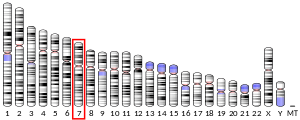| CLIP2 |
|---|
 |
|
| Identifiers |
|---|
| Aliases | CLIP2, CLIP, CLIP-115, CYLN2, WBSCR3, WBSCR4, WSCR3, WSCR4, CAP-Gly domain containing linker protein 2 |
|---|
| External IDs | MGI: 1313136 HomoloGene: 20718 GeneCards: CLIP2 |
|---|
|
| Gene location (Mouse) |
|---|
 | | Chr. | Chromosome 5 (mouse)[2] |
|---|
| | Band | 5 G2|5 74.63 cM | Start | 134,489,383 bp[2] |
|---|
| End | 134,552,434 bp[2] |
|---|
|
|
| Orthologs |
|---|
| Species | Human | Mouse |
|---|
| Entrez | | |
|---|
| Ensembl | | |
|---|
| UniProt | | |
|---|
| RefSeq (mRNA) | | |
|---|
| RefSeq (protein) | | |
|---|
| Location (UCSC) | Chr 7: 74.29 – 74.41 Mb | Chr 5: 134.49 – 134.55 Mb |
|---|
| PubMed search | [3] | [4] |
|---|
| Wikidata |
|
CAP-Gly domain-containing linker protein 2 is a protein that in humans is encoded by the CLIP2 gene.[5][6][7]
The protein encoded by this gene belongs to the family of cytoplasmic linker proteins, which have been proposed to mediate the interaction between specific membranous organelles and microtubules. This protein was found to associate with both microtubules and an organelle called the dendritic lamellar body. This gene is hemizygously deleted in Williams syndrome, a multisystem developmental disorder caused by the deletion of contiguous genes at 7q11.23. Alternative splicing of this gene generates 2 transcript variants.[7]
References
- 1 2 3 GRCh38: Ensembl release 89: ENSG00000106665 - Ensembl, May 2017
- 1 2 3 GRCm38: Ensembl release 89: ENSMUSG00000063146 - Ensembl, May 2017
- ↑ "Human PubMed Reference:".
- ↑ "Mouse PubMed Reference:".
- ↑ Osborne LR, Martindale D, Scherer SW, Shi XM, Huizenga J, Heng HH, Costa T, Pober B, Lew L, Brinkman J, Rommens J, Koop B, Tsui LC (Jan 1997). "Identification of genes from a 500-kb region at 7q11.23 that is commonly deleted in Williams syndrome patients". Genomics. 36 (2): 328–36. doi:10.1006/geno.1996.0469. PMID 8812460.
- ↑ Hoogenraad CC, Eussen BH, Langeveld A, van Haperen R, Winterberg S, Wouters CH, Grosveld F, De Zeeuw CI, Galjart N (Dec 1998). "The murine CYLN2 gene: genomic organization, chromosome localization, and comparison to the human gene that is located within the 7q11.23 Williams syndrome critical region". Genomics. 53 (3): 348–58. doi:10.1006/geno.1998.5529. PMID 9799601.
- 1 2 "Entrez Gene: CLIP2 CAP-GLY domain containing linker protein 2".
Further reading
- Nakajima D, Okazaki N, Yamakawa H, et al. (2003). "Construction of expression-ready cDNA clones for KIAA genes: manual curation of 330 KIAA cDNA clones". DNA Res. 9 (3): 99–106. doi:10.1093/dnares/9.3.99. PMID 12168954.
- Ohara O, Nagase T, Ishikawa K, et al. (1997). "Construction and characterization of human brain cDNA libraries suitable for analysis of cDNA clones encoding relatively large proteins". DNA Res. 4 (1): 53–9. doi:10.1093/dnares/4.1.53. PMID 9179496.
- The Sanger Centre; The Washington University Genome Sequencing Center (1999). "Toward a complete human genome sequence". Genome Res. 8 (11): 1097–108. doi:10.1101/gr.8.11.1097. PMID 9847074.
- Corper AL, Stratmann T, Apostolopoulos V, et al. (2000). "A structural framework for deciphering the link between I-Ag7 and autoimmune diabetes". Science. 288 (5465): 505–11. doi:10.1126/science.288.5465.505. PMID 10775108.
- Akhmanova A, Hoogenraad CC, Drabek K, et al. (2001). "Clasps are CLIP-115 and -170 associating proteins involved in the regional regulation of microtubule dynamics in motile fibroblasts". Cell. 104 (6): 923–35. doi:10.1016/S0092-8674(01)00288-4. PMID 11290329.
- Hoogenraad CC, Koekkoek B, Akhmanova A, et al. (2002). "Targeted mutation of Cyln2 in the Williams syndrome critical region links CLIP-115 haploinsufficiency to neurodevelopmental abnormalities in mice". Nat. Genet. 32 (1): 116–27. doi:10.1038/ng954. PMID 12195424.
- Strausberg RL, Feingold EA, Grouse LH, et al. (2003). "Generation and initial analysis of more than 15,000 full-length human and mouse cDNA sequences". Proc. Natl. Acad. Sci. U.S.A. 99 (26): 16899–903. doi:10.1073/pnas.242603899. PMC 139241. PMID 12477932.
- Hillier LW, Fulton RS, Fulton LA, et al. (2003). "The DNA sequence of human chromosome 7". Nature. 424 (6945): 157–64. doi:10.1038/nature01782. PMID 12853948.
- Navarro-Lérida I, Martínez Moreno M, Roncal F, et al. (2004). "Proteomic identification of brain proteins that interact with dynein light chain LC8". Proteomics. 4 (2): 339–46. doi:10.1002/pmic.200300528. PMID 14760703.
- Evgrafov OV, Mersiyanova I, Irobi J, et al. (2004). "Mutant small heat-shock protein 27 causes axonal Charcot-Marie-Tooth disease and distal hereditary motor neuropathy". Nat. Genet. 36 (6): 602–6. doi:10.1038/ng1354. PMID 15122254.
- Cheng J, Kapranov P, Drenkow J, et al. (2005). "Transcriptional maps of 10 human chromosomes at 5-nucleotide resolution". Science. 308 (5725): 1149–54. doi:10.1126/science.1108625. PMID 15790807.
- Olsen JV, Blagoev B, Gnad F, et al. (2006). "Global, in vivo, and site-specific phosphorylation dynamics in signaling networks". Cell. 127 (3): 635–48. doi:10.1016/j.cell.2006.09.026. PMID 17081983.
PDB gallery |
|---|
2cp2: Solution structure of the 1st CAP-Gly domain in human CLIP-115/CYLN2 2cp3: Solution structure of the 2nd CAP-Gly domain in human CLIP-115/CYLN2 |







